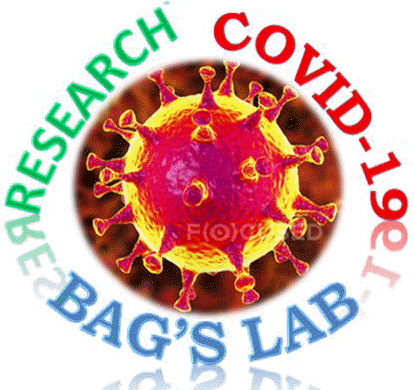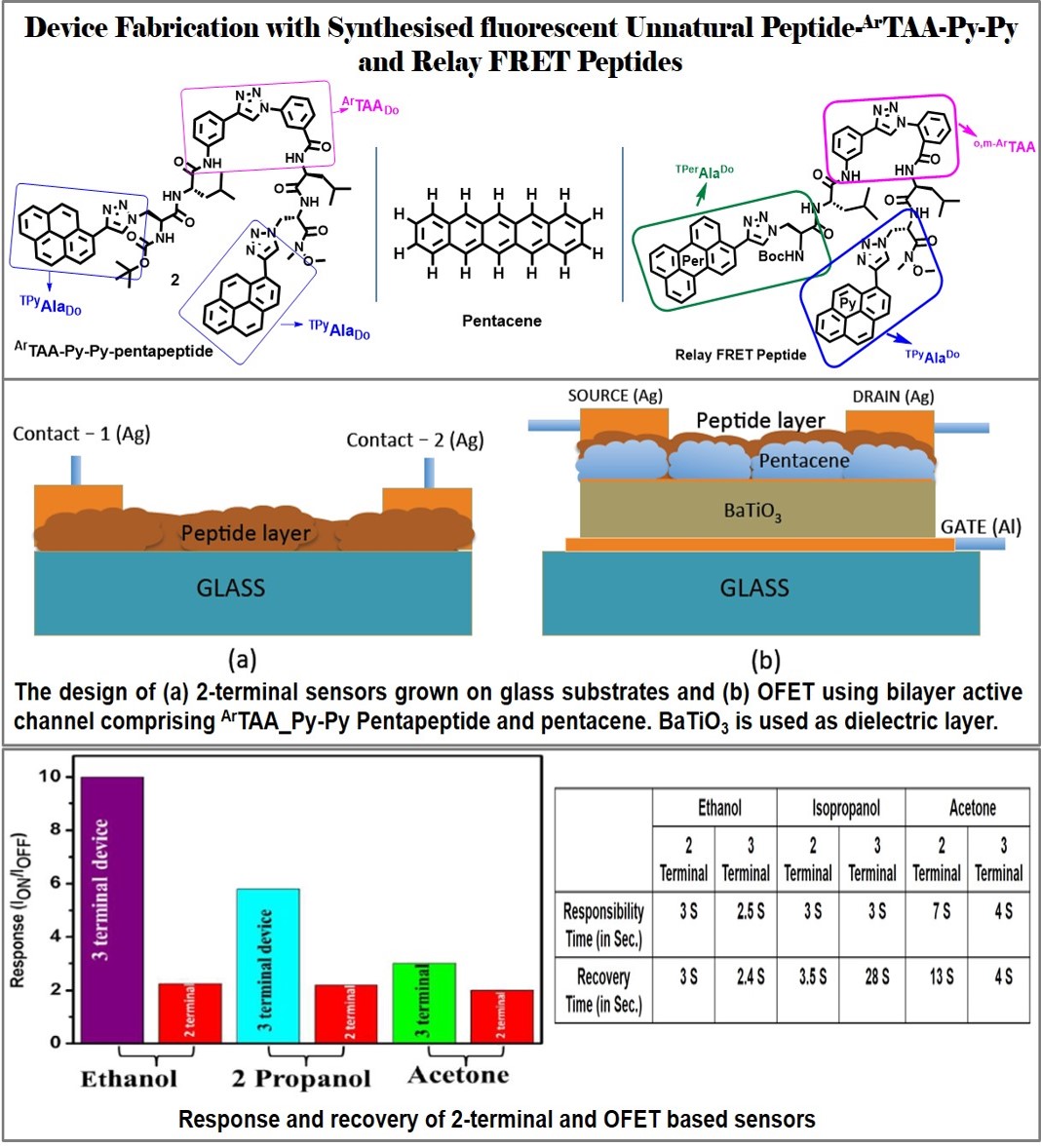|
Home Biography Research Few Publications Full List of Publications Graphical Abstract Project Funding Collaborators Courses Group Members Photo Gallery |

|
|
|
| Chemical/Biological Sensor Development |
|
Overview: My other untiring innovations include the development of fluorescent sensors based on small fluorescent molecules (ligand), fluorescent unnatural nucleosides/ DNA probes, fluorescent unnatural amino acids/peptides. These probes have been utilized for label-free sensing of DNA / protein biomolecules, which would have a great impact on the screening of drug candidates. Thus, owing to the impact and wide applications of label-free sensing in drug development research he has utilized the “Just-Mix-&-Read Strategy” for sensing of DNA biomolecules such as ct-DNA. The same strategy has also been applied for sensing of protein biomolecules such as BSA, amylase etc. I have also extended his work for the detection and quantification of environmental hazardous metal ions such as Pb2+, Hg2+, Cu2+ etc. by exploiting the developed nanoparticles, fluorescent amino acids and small fluorescent molecules. We are thus, engaged in synthesizing small fluorescent molecules for sensing biological macromolecules or using as fluorescent sensor. Toward this end we have reported the versatile use of triazolyl-pyrene based Click-Fluorophore for metal sensing (Tetrahedron Lett. 2012, 53, 5875) as well as for the sensing of biomolecules and label free discrimination of mismatched DNA (Tetrahedron Letters 2013, 54, 2627). The real beauty and multifunctional feature of this molecules also captured in the sensing of miceller microenvironment (mimic of cell membrane) with a switch-on fluorescence signal (J. Fluorescence 2013, 23, 939.). Binding to the minor groove of calf-thymus DNA (ct-DNA) and strong binding in hydrophobic pocket of bovine serum albumin (BSA), switched-on the fluorescence of smart fluorescent probe, triazolylpyrene (TNDMBPy). Also, a novel label free strategy was adopted to detect DNA base mismatch via the generation of distinct fluorescence signal at visible region utilizing the same probe (Bioorg. Med. Chem.Lett. 2012, 23, 96). We also reported our new methodology on the Mn2+-catalysed synthesis of donor/acceptor substituted classical fluorescent phenoxazine which showed high solvatochromic emission property and ct-DNA sensing efficiency via light-up fluorescence response (RSC Adv. 2013, 3, 5374). In water Hg2+ sensor has been developed based on simple bis-pyridobenzene as a fluorescence light-up probe (Sensors & Actuators: B. Chemical 2017, 238, 903). We have synthesized highly solvatochromic fluorescent naphthalimides which was found to be efficient in fluorescence switch-on sensing of ct-DNA (Bioorg. Med. Chem. Lett. 2009, 19, 6392). We have reported the detection of Cu2+ ion with fluorescence light-up probe, triazolylpyrene (TNDMBPy). Thus, the probe showed a remarkable fluorescence enhancement of both monomer and excimer emissions and a 2:1 probe-Cu2+ complexation with high selectivity and stability constant. Our probe is also capable of sensing SDS micelle-encapsulated-Cu2+ ion in aqueous media proving its potential practical utility. Formation of excimer was also supported by DFT calculation (Tet. Lett. 2012, 53, 5875). Recently we applied our synthesized Atropomer, the Aromatic Triazolo Unnatural Amino acid for Fluorescence Discrimination of Alcohol (New J. Chem., 2017, 41, 13391). A label free strategy has been utilized for sensing of homopyrimidine base mismatches, abasic site and bulge DNA with the help of fluorescent tetrazolyl pyrene unnatural nucleoside as probe (J. Photochem. Photobiol. B 2017, 173, 165). The same nucleoside sensor has been utilized for specific detection of higher order G-quadruplex DNA (Org. Biomol. Chem., 2017, 15, 10145, Front Cover Page) and sensing of protein BSA (Communicated). This is first example of fluorescent unnatural nucleoside as probe for label free DNA detection. Recently, we published Pyrenylthioureayl Alanine as a Selective Switch-on Fluorescent Sensor for Hg2+ and Cu2+ (Chemistry Select 2018, 3, 11758-11764). Fluorescent Antimicrobial Peptide-based Bacteria/Virus Sensor: We are now engaged in developing bioinspired materials and antimicrobial peptide based biomaterial for possible clinical use. We are engaged in creating new and novel therapeutic alternatives against the recent rise of multidrug-resistant microbial strains. We have put up a project proposal based on the recent call for Team Science Grant & Clinical/Public Health Research Centres Grants from IndiaAlliance DBT. We want to exploit the β-turn/β-sheet Peptidomimetics developed by Dr. Bag, Peptoids by Prof. Aaron and the Surface tethering techniques by Prof. Lalit at BSBE Department of IITG to create therapeutic surfaces. The bioinspired materials based on fluorescent peptidomimetics developed by me could also find applications in sensing and medical diagnostic purposes. This project would have great impact to resist virus protein capsids, such as SARS-CoV-2 and similar SARS viruses, from surface attachment.
Fluorescent Peptide-Based OFET Sensor: In recent times we are involved in the development of sensing devices for the detection of Explosives, alcohols, and biological threats using Organic Field-Effect Transistors (OFET) based on unnatural fluorescent peptides and fluorescent chiral polymers. The fabricated device is shown in the figure below.
We have developed a semiconducting bilayer geometry in OFET design. It includes one highly conducting pentacene layer coated with a fluorescent peptide layer (fluorescent ArTAA_Py-Py pentapeptide). Such a device has been tested for the detection of polar gas molecules like alcohol and acetone. It also can detect blood proteins in solutions successfully. This is the first example of a peptide based OFET device which is thus unique in design. It is advantageous in comparision to other available gas sensing divices as it works efficiently at room temperature, exhibits higher selectivity and enhanced sensitivity with comparably fast response time (~ 3sec) and recovery time (~4sec). Additionally, they are also working to integrate microfluidic channels to convert OFETs for the rapid detection of biomolecules in the solution phase for Biomedical application and also would be extended for the detection of chemical/biological warfare agents for Defense application.
|


